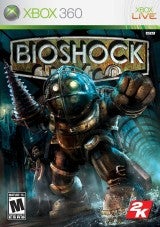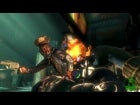Ken Levine: Yeah.Patrick: Me too. I don't know about Sterling, but I had a little bit of a tough time with deciding whether or not to harvest the Adam (kill the Little Sister), but the second time, it was a foregone conclusion.
Sterling: I couldn't do it the first time, but the second time, the game advised me that without extra Adam, I'd probably die a lot if I went any further, so the second time, "sorry, little mutated girl..."
Ken Levine: Well, that's what's interesting about it; it's not just a gameplay decision. In no way do I think it's a reflection on someone's personality; I think it's very important. That's what I meant about "Schindler's List;" it's very important to be in that guy's head understanding what he is, so I think it's great that people react to it.

Patrick: In the old System Shock games, we saw a really early version of this idea of story that doesn't take away from the shooting. We heard this from the team working on Blacksite: Area 51, and we're hearing it from other games in which the story aspects flow into the shooting aspects. Do you think that's pulling from System Shock 2, or do you think that's just a progression of next-gen game development?
Ken Levine: We were fortunate in that we used the message system in System Shock, like e-mails, in order to frame the story. Because of our budget, we had a certain idea of mise en scene, in which you can look around the world and visually tell the story. We spent a great deal of time on BioShock working on those details and telling the story, because look, while I'm not against it, people are going to get ten percent of the story because they're skipping the in-game messages. I want them to understand what's happened here. I want them to at least be able to piece together the basic story of what happened in Rapture. Granted, if they listen to the audio diaries, they'll really get a better idea of what happened, but it has to work on multiple levels.Patrick: So, on one of those levels, you're trying to guess based on audio cues, which one is the SHODAN? I don't know if it's deliberate, but it's like watching "24" and saying, "oh, that's the bad one; he's too nice. Oh wait, he just told me to kill a little girl to survive, maybe he is looking out for me." One of them's gotta be an AI; I'm just sayin'.
Ken Levine: The point of that scene between Tenenbaum and Atlas [Ed. Note: the first scene in which you'll be faced with whether or not to harvest Adam from a Little Sister] should leave you to question, "who do I believe?" Even with Ryan from the beginning, who's supposed to be the villain of it all. He says something that's totally right, and made this beautiful place. And that's what it's about, not exactly knowing what to do or having to decide between right and wrong. That's something that you encounter everyday in life.Sterling: Segueing away from storyline a little, what sorts of hardware limits did the team encounter from pre-production leading up to this point of near-completion?
Ken Levine: As a credit to my programming team, honestly, I didn't hear much about them. There was some hesistation on the part of some of programming team in pushing a level of physical simulation in the world, in part because they knew how much work that was. To their credit, I'll say, not only did they do it, they knocked it out of the park, because I've never seen this level of simulation ever in a shooter. From fire to electricity, the water and the number of physical objects in the space, and even the ragdoll physics and animation, there was a lot of simulation that I wanted to do, and they really did hit it out of the park. From where I'm sitting, there were no limits, but from where they were sitting, it was probably a miserable twelve months of working, working, working, working.





